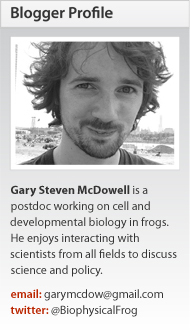-
October 21, 2015
Advocating for changes to science at Future of ... -
September 19, 2015
Chicago Postdocs To Discuss Training, Science P... -
September 13, 2015
Listening to our universe with gravitational wa... -
June 09, 2015
Science Visualization at the VIVID Festival -
April 20, 2015
Postdoc Advocates Step Into the Spotlight at Na... -
March 19, 2015
Conferences to engage and build communities -
February 27, 2015
The Organization and Execution of a Postdoc-Run... -
January 19, 2015
Scientific Meetings and Advocacy: same place, d... -
December 27, 2014
The Future of Research Symposium -
November 10, 2014
Join the Twitter Chorus -
July 03, 2014
More than Just Meetings - Xenopus, Advanced Ima... -
June 26, 2014
Singer for your Supper - BYG2014 Singer Session -
June 26, 2014
A yeast-y world view - British Yeast Group 2014... -
May 31, 2014
A New View on Life - BioVisions (#BVA2014) -
April 26, 2014
55th Annual Drosophila Research Conference (#Dr... -
April 04, 2014
SynBio Future - Synthetic biology for the masses! -
March 17, 2014
Science. Polish Perspectives (#SPP2013) -
February 17, 2014
2013 ASCB Annual Meeting - #ASCB2013 -
December 02, 2013
Science Online: Oceans - #SciOOceans -
November 25, 2013
Molecular Biology & Pathogenesis of the Clostri... -
September 20, 2013
Science Online Climate - #SciOClimate -
August 17, 2013
Let's go round again - One year of Conference C... -
August 07, 2013
Communicating Science 2013 (ComSciCon13) -
July 25, 2013
International Society for Stem Cell Research 20... -
July 11, 2013
#pombe2013 - 6 days in 6 ways: Saturday/Mindmaps -
July 10, 2013
#pombe2013 - 6 days in 6 ways: Friday/Twitter -
July 09, 2013
#pombe2013 - 6 days in 6 ways: Thursday/Blogging -
July 08, 2013
#pombe2013 - 6 days in 6 ways: Wednesday/Headlines -
July 05, 2013
#pombe2013 - 6 days in 6 ways: Tuesday/Scribing -
July 04, 2013
#pombe2013 - 6 days in 6 ways: Monday/Instagram -
June 08, 2013
Getting Together: Science Speed Dating -
May 31, 2013
Scientific Vision: Imagery in Science & Confere... -
May 24, 2013
BSA Science Communication 2013 (#SciComm2013) -
May 19, 2013
Science mojo: Gradually diminished, instantly r... -
May 01, 2013
Flying High - 54th Annual Drosophila Research C... -
April 01, 2013
Spring Conferences 2013 - April -
February 19, 2013
SpotOn NYC (SONYC) - Doodling Science -
January 01, 2013
Falling Walls Lab Berlin 2012 - Competition -
December 30, 2012
Falling Walls Lab Berlin 2012 - Preliminaries -
December 29, 2012
Falling Walls Lab Berlin 2012 - 3 minutes, 1 day -
December 17, 2012
Science. Polish Perspectives (SPP2012) -
December 08, 2012
21th International Colloquium on Magnetic Films... -
December 03, 2012
SpotOn London 2012 (#solo12): Starting a Conver... -
November 25, 2012
SpotOn London 2012 (#solo12): Connecting the Dots -
November 24, 2012
SpotOn London 2012 (#solo12): How Fringe Sessio... -
November 18, 2012
14th Xenopus International Conference - Days 4 & 5 -
November 15, 2012
14th Xenopus International Conference - Days 1 ... -
October 10, 2012
European Conference on Computational Biology (E... -
October 08, 2012
European Conference on Computational Biology (E... -
September 28, 2012
The International Conference on Science Communi... -
September 21, 2012
4th International Congress on Stem Cells and Ti... -
September 17, 2012
ESA2012 - Through the magic of Twitter-vision -
September 17, 2012
Ecological Society of America (ESA) 2012 - In R... -
September 10, 2012
European Conference on Computational Biology (E... -
September 07, 2012
FASEB - Protein Folding in the Cell -
August 17, 2012
Hermes 2012 - A Scientific Surprise -
August 14, 2012
UKCSJ - UK Conference of Science Journalists -
August 12, 2012
IWPCTM13 - International Workshop on the Physic... -
August 10, 2012
Looking Ahead - Conferences in Aug/Sept 2012 -
August 09, 2012
Conference Cast Reloaded -
September 14, 2011
EMBO conference - day four -
September 13, 2011
EMBO conference - day three -
September 12, 2011
EMBO conference - day two -
September 11, 2011
EMBO conference - day one -
July 17, 2011
SFAM conference - day four -
July 16, 2011
SFAM conference - day three -
July 14, 2011
SFAM conference - day two -
July 14, 2011
SFAM conference - day one -
June 21, 2011
Structural Systems Biology Conference - Part II -
June 20, 2011
Structural Systems Biology Conference - Part I -
May 07, 2011
BSCB-BSDB Spring Conference - Day 4 -
May 05, 2011
BSCB-BSDB Spring Conference - Day 3 -
May 03, 2011
BSCB-BSDB Spring Conference - Day 2 -
May 02, 2011
BSCB-BSDB Spring Conference - Day 1 -
April 19, 2011
Society for General Microbiology Conference - S... -
April 11, 2011
SciBarCamb2011 -
March 18, 2011
OMNG - Day 3 -
March 16, 2011
OMNG - Day 2 -
March 15, 2011
OMGN - Day 1 -
February 12, 2011
SciOnline - Student Reflections III
« Prev « Prev Next » Next »




 Ok, so this is probably the nerdiest thing I’ve ever seen
anyone do when planning a conference, and after nearly seven years at the
University of Cambridge, that’s really saying something.
Ok, so this is probably the nerdiest thing I’ve ever seen
anyone do when planning a conference, and after nearly seven years at the
University of Cambridge, that’s really saying something. Now, bearing in mind that this conference is being organised
by a collection of scientists with an interest in using computers to solve
large scale biological problems, that your group of scientists don’t easily
divide into two equal groups and that your organisers are all pretty much a
massive collection of bio-computing nerds. It would, of course, be far too easy
to follow a standard speed dating paradigm. It’s much more fun to collect data
on all of your conference delegates and use scientific clustering methods and
network building algorithms to pair up the scientists in attendance based on
their keenest interests. So, with much credit in particular to Federico Vaggi (a member of the
Now, bearing in mind that this conference is being organised
by a collection of scientists with an interest in using computers to solve
large scale biological problems, that your group of scientists don’t easily
divide into two equal groups and that your organisers are all pretty much a
massive collection of bio-computing nerds. It would, of course, be far too easy
to follow a standard speed dating paradigm. It’s much more fun to collect data
on all of your conference delegates and use scientific clustering methods and
network building algorithms to pair up the scientists in attendance based on
their keenest interests. So, with much credit in particular to Federico Vaggi (a member of the  For the first five dates, it was about meeting people you’ve
never met before and explanding academic horizons. So you can’t pair up people
that have collaborated and ideally you want to match people that are on
opposite sides of the collaboration network (i.e. haven’t even worked with
people who have worked with their match before). People were also paired up
based on the things that they knew, meaning that partners had little or no
common academic knowledge and so would have lots to tell each other about.
For the first five dates, it was about meeting people you’ve
never met before and explanding academic horizons. So you can’t pair up people
that have collaborated and ideally you want to match people that are on
opposite sides of the collaboration network (i.e. haven’t even worked with
people who have worked with their match before). People were also paired up
based on the things that they knew, meaning that partners had little or no
common academic knowledge and so would have lots to tell each other about. Even for the small number of people at this conference
(about 40) the number of possible pairings is astronomical (something like – 319 830 986 772 877 770 815 625) so even computationally this is
a really difficult problem to solve. Through complicated maths you can put
together a graph of the favourability of different pairings and solve it to
give the best combination of dates.
Even for the small number of people at this conference
(about 40) the number of possible pairings is astronomical (something like – 319 830 986 772 877 770 815 625) so even computationally this is
a really difficult problem to solve. Through complicated maths you can put
together a graph of the favourability of different pairings and solve it to
give the best combination of dates.


















Just to add a bit background to it, the concept of mixing scientists came from a mathematics meeting in Germany at the Mathematisches Forschungsinstitut Oberwolfach, where each participant has a napkin holder and these are randomly distributed for each meal to mix the people.
At Chicheley hall we did not have seven days to let the people mix by this random choice, but when we saw the circular discussion table during our site visit we came with the idea of speed-dating (not that we knew more about it than from films). Quickly we realized we do not have enough theoreticians to match their number with experimentalists to create two 'genders' , thus we came up with the idea of network directed approach to reduce the number of ‘dates’. Co-authorship network has a long delay to in depth scientific discussion, thus we sent a survey to participants to build their network. The rest is explained here nicely.
I do think we need to come up with a better name, because 'scientific speed dating' conjures up very awkward mental images. It's just easier to talk about 'speed dating' than 'Minimizing the L2 loss in mutual knowledge space'. Any suggestions for alternative names are very welcome, we got a few suggestions, but they were even more dire (someone at the conference suggested 'forced pairings').
We didn't have formal seating arrangements... there were some couches, some seats with tables, while some people opted to talk standing up while drinking coffee. Since we had some posters up for the poster session, what happened sometime is that people would start talking at a table, then they'd really get into the science, and move to a poster to talk in detail about a specific point.
Before the session began, we handed everyone a sheet telling everyone who they would be sitting with. We ended the sessions after 15 minutes sharp by ringing a bell, because scientists have this tendency to get carried away when talking about their work! As Jonathan talked about, we had a total of 10 'dates', split into two sets of five, using very different rules.